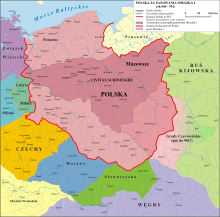Civitas Schinesghe
Civitas Schinesghe Państwo Gnieźnieńskie ( Polish ) | |||||||||||
|---|---|---|---|---|---|---|---|---|---|---|---|
| 966–1025 | |||||||||||
Mieszko I | |||||||||||
• 992–1025 | Bolesław I the Brave | ||||||||||
| History | |||||||||||
• Baptism of Poland | 966 | ||||||||||
• Coronation of Bolesław I the Brave | 1025 | ||||||||||
| |||||||||||
Civitas Schinesghe (
Etymology
Civitas Schinesghe, meaning "Gniezno State", is the first recorded name related to
Though the proper Latin name for Poland, Polonia, which came into use some time later, is not explicitly used in the document, the name Schinesghe presumably refers to Gniezno, which was one of the main gord strongholds of the West Slavic tribe of Polans. According to philological analysis, the letters "Sc" were substituted for the letter "K," thus the original record would therefore read "Khinesghe" or "Kninesne." Another theory posits the name as an imperfect Latinization of hrady knezske or grody książęce, "ducal gords."[3]
History

In 966,
Following the death of Mieszko I, his eldest son,
Territory

The Dagome iudex outlines the borders of the Polish realm:[8]
- sicuti incipit a primo latere longum mare, "as it starts from the first side of a long sea" (presumably the Pomeranian coast – on the Baltic Sea)
- fine Bruzze 'end Bruzze' – "along the Prussian borders" (settlement area of the Old Prussians)
- usque in locum, qui dicitur Russe – "up to a place called Masovia)
- et fines Russe extendente usque in Craccoa – " Rus' ends and extending into Kraków"
- et ab ipsa Craccoa usque ad flumen Odde recte – "and from there right along the Oder river"
- in locum, qui dicitur Alemure, "in a place called The Alemure" (sometimes identified as Olomouc in Moravia or possibly Oława in Silesia)
- et ab ipsa Alemura usque in terram Milze recte intra Oddere – "to the Margraviate of Meissen)
- et exinde ducente iuxta flumen Oddera usque in predictam civitate Schinesghe. – "and from its borders along the Oder to aforementioned Schinesghe."
See also
- List of Polish monarchs
- Poland in the Early Middle Ages
- Culture of medieval Poland
- History of Poland
Notes
- ISBN 978-0-313-03456-5.
- ISBN 978-90-04-18136-6.
- ^ According to Brygida Kürbis, the initial "Sc" is mistakenly recorded from "K". The original record would therefore read "Kninesne" or "Khinesghe". Dowiat, Jerzy (1961). Metryka chrztu Mieszka I i jej geneza. Warszawa. p. 91.
{{cite book}}: CS1 maint: location missing publisher (link) - ISBN 978-1-137-40281-3.
- ISBN 978-1-61069-566-4.
- OCLC 174416485.
- ISBN 978-0-231-12817-9.
- ^ Kürbis, B. Dagome iudex. Studium krytyczne. pp. 362–423.
References
- Kurbis, Brygida (1962). Dagome iudex. Studium krytyczne [in:] Początki państwa polskiego – Księga Tysiąclecia vol. 2. Poznań.
{{cite book}}: CS1 maint: location missing publisher (link) - Piskorski, Jan Maria (August 2004). Civitas Schinesghe. Mieszko I i początki państwa polskiego. Poznańskie Towarzystwo Przyjaciół Nauk. ISBN 83-7063-416-8.

